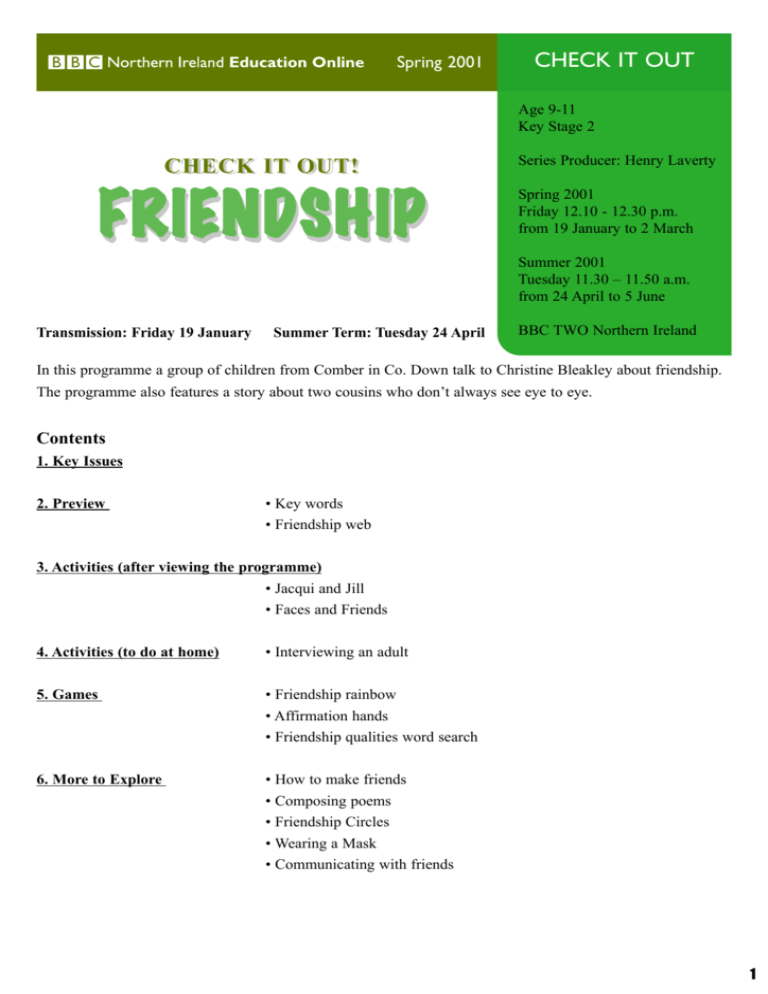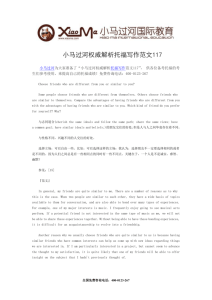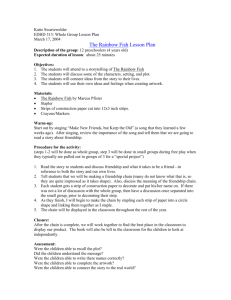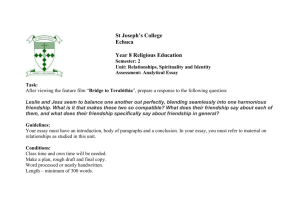00597 Friends and Enemies
advertisement

Spring 2001 CHECK IT OUT Age 9-11 Key Stage 2 CHECK CHECK IT IT OUT! OUT! FRIENDSHIP Series Producer: Henry Laverty Spring 2001 Friday 12.10 - 12.30 p.m. from 19 January to 2 March Summer 2001 Tuesday 11.30 – 11.50 a.m. from 24 April to 5 June Transmission: Friday 19 January Summer Term: Tuesday 24 April BBC TWO Northern Ireland In this programme a group of children from Comber in Co. Down talk to Christine Bleakley about friendship. The programme also features a story about two cousins who don’t always see eye to eye. Contents 1. Key Issues 2. Preview • Key words • Friendship web 3. Activities (after viewing the programme) • Jacqui and Jill • Faces and Friends 4. Activities (to do at home) • Interviewing an adult 5. Games • Friendship rainbow • Affirmation hands • Friendship qualities word search 6. More to Explore • How to make friends • Composing poems • Friendship Circles • Wearing a Mask • Communicating with friends 1 Spring 2001 CHECK IT OUT KEY ISSUES This programme aims to explore friendship and to consider: • what makes someone a friend • what we expect from our friends • why we have the friends we have • what kinds of things we can do together with friends • how friends can be the same as us or different to us • how we feel when we fall out with a friend • what might make someone an enemy PREVIEW It is suggested that this section is completed prior to viewing the programme. KEY WORDS The following key words may need to be clarified: FRIENDS UNDERSTANDING FRIENDSHIP FORGIVENESS ENEMIES TRUST ACCEPTANCE PERSONALIT Y BETRAYAL 2 Spring 2001 CHECK IT OUT PREVIEW Contd… Friendship Web Class or group activity. Ask the children to brainstorm what qualities they would expect a friend to have. Afterwards, they could agree on a list of prioritised qualities which they could record in a web style as shown below. They could also brainstorm what activities they share with their friends, e.g. swimming; going to the park; riding scooters; playing football; going to the GB/Scouts; listening to music. This might be more manageable for younger children and it still offers the opportunity for discussion about the qualities which friends should have. FRIENDS 3 Spring 2001 CHECK IT OUT ACTIVITIES - after viewing the programme Jacqui and Jill The children should have watched the programme before completing this activity. Recount the story about Jacqui and Jill to ensure the children understand what happened. Discuss the relationship between Jacqui and Jill. The children should work in groups of three to allow for maximum interaction and participation. They should then complete the worksheet. The teacher could then list the main ideas on an enlarged worksheet. Does jealousy feature as a reason for people not being friendly? What other reasons are given for children not being friends? Emphasis should be placed on the notion of friends being different but possibly having something in common. 4 Spring 2001 CHECK IT OUT JACQUI AND JILL WORKSHEET Why do you think the two girls were not friendly? What changed to make them become friendly? Do people have to be alike to be friends? Why/why not? 5 Spring 2001 ACTIVITIES - after viewing the programme CHECK IT OUT Contd… Faces and Friends Recall the masks made by the children in the programme. This may be a good opportunity to discuss the phrase used by one child in the programme "Unfriendly is unhappy". Do pupils think this is true? Why do they think this? Use pictures from magazines to look at people’s expressions and to help pupils focus on the ideas being discussed. Use different colours, symbols, images and shapes to make masks portraying friendly/unfriendly faces. The children should have the opportunity to discuss their masks either with a partner or with the whole class. 6 Spring 2001 CHECK IT OUT ACTIVITIES - to do at home Interviewing an Adult about Friendship Discuss the idea of "lifelong" friends with the whole class. You may need to define what "lifelong" means. • Do they know anyone who has a lifelong friend? • What would be the benefits of having such a friend? • How could they find out more about such a friendship? • Guide them to the idea of asking someone in such a position about their experiences. Ask pupils to work in small groups to compose suitable questions which they could ask an adult. Ask pupils to share their lists with the class and then agree a single set of questions with the whole class. These may then be used for the Take it Home activity. Ask pupils to use the list of questions to interview a suitable adult at home. Responses could be taped or recorded in written form with the help of the adult. Alternatively the list of questions could be used to interview a suitable visitor to the classroom. This could also involve the children composing an invitation to be sent to the proposed visitor. The findings from the interview could be discussed during an open forum and conclusions recorded by the teacher. 7 Spring 2001 CHECK IT OUT GAMES Friendship Rainbow This game can be used in a variety of ways. Each pupil receives a copy of the Friendship Rainbow. They then write their name in one band of the Rainbow and a brief phrase to describe what they think is the most important thing about a friend. This band can then be coloured in and passed to another person (perhaps someone who sits at their table or near to them) who repeats the process. This continues until each child’s rainbow is completed. An alternative approach is for the "owner" of the Friendship Rainbow to write his/her name in a cloud. The sheet is passed around to other pupils who then volunteer to make contributions. Each pupil identifies a positive quality about the child who owns the rainbow and writes this in one band before passing it on. This activity could be linked to lessons on adjectives, where pupils could discuss or undertake further written work looking at words which are used to describe people. The rainbow can then be used for display and discussion purposes. 8 CHECK IT OUT My Rainbow Spring 2001 9 Spring 2001 CHECK IT OUT GAMES Contd… Affirmation Hands Each pupil draws an outline of their hand on a sheet of paper and puts their name on it. In small groups the sheets are passed around and everyone is asked to write on the “hand” something positive about what makes that person a good friend. Make it clear that negative remarks are not allowed. Pupils could sign their names to their remarks. They could also share what is written on their “hand” with the rest of the group and perhaps discuss how they feel about it. The “hands” may then be put on display. 10 CHECK IT OUT Spring 2001 GAMES Contd… Friendship Qualities Word Search Encourage pupils to discuss friendship qualities in pairs or small groups. Ask them to think about the qualities in the word search and to identify which ones they think are most important and which they think are not important at all. Complete the word search. Words may be spelt horizontally or vertically. Circle each word as you find it. a i c a r i n g p r i a f t e t g j t n e i t a p j t r v e a l k i t a u b y l n e w z k i f m o p m k a s e h b r g a h n s u c c h n v o a i t q d u l z t a t w r v w m l o y a l i r r e v e l c c v d r s v i t r u t h f u l x g y e n a v e x p r s u o l i o g w e a l t h y a w b t g n i d n a t s r e d n u x t r u s t w o r t h y a sharing caring patient brave talent attractive fair clever truthful loyal reliable wealthy understanding kind trustworthy popular neat 11 Spring 2001 CHECK IT OUT MORE TO EXPLORE How to make Friends NEW FRIEND I’m standing in the playground, And I’m standing all alone, My only friend’s away today. I think she’s ill at home. I’m feeling very lonely And I think that I might cry. I’d really like to play with you, But I know I’m much too shy. Perhaps I’ll just stand near you, And maybe ask your name, And if you smile and talk to me Perhaps we’ll play a game. I’m running in the playground, I’m playing "It" with Jo. I think I’ve got a new friend now, I’m glad I said, "Hello". (Poems for Circle Time and Literacy Hour - Margaret Goldthorpe • LDA) Read the first two verses of the poem to the class. Discuss with the pupils how the person is feeling. The teacher may record these feelings in a list. Talk about occasions when pupils have felt like this. Divide the class into smaller groups and discuss what the person in the poem could do to improve the situation, e.g. make friends. Responses could be recorded in a list or in pictorial form. Each group could share their ideas with the whole class. Read the whole poem to the children and afterwards discuss what this person actually did. Small group work could be extended to a discussion about what pupils could do if they were in the playground and saw someone standing alone. Role plays could be undertaken and performed by each group. Discuss a situation where the children might have to make new friends to help make the information relevant to them, e.g. going to a new school or club. 12 Spring 2001 CHECK IT OUT MORE TO EXPLORE Contd… Composing Poems Ask the class to complete the sentence "Happiness is…." Discuss the phrases suggested and what happiness means to the children. In groups ask the children to complete sentences beginning with "Friendship is…". The friendship web activity (in Preview) should be completed first so the children have access to suitable phrases and vocabulary. Each group should share their sentences with the rest of the class to instigate discussion about different ideas and provide an opportunity for praise. The phrases could be put together to form poems, which could be used for display purposes. 13 Spring 2001 CHECK IT OUT MORE TO EXPLORE Contd… Rounds for Circle Time Circle Time is a time for group discussion during which adults and children sit together in a circle. An agreed set of ground rules should be established from the beginning, such as - no put downs; encourage one another; it is okay to make mistakes, etc. The subject matter can be teacher-initiated or the choice of a child or children. Within the circle, children learn to look and to listen, to share their ideas and feelings, and to develop an identity with the rest of the group. Circle time provides an ideal opportunity to raise and discuss issues such as friendship, honesty, respect, prejudices and so on through stories, role plays and such like. Start discussing matter-of-fact subjects then progress onto more sensitive issues when the pupils feel more secure. Conflict resolution skills could be introduced and life skills investigated. Friendship Circles Ask pupils to introduce the person next to them after a short discussion. Using sticky labels, ask pupils to write their name and a quality they have which makes them a good friend. They can then introduce themselves. Ask the pupils to discuss with a partner what he/she likes doing. This is my friend and he/she likes ___________________________________ Ask the pupils to complete the following sentences: • My friend is ___________________________________________________ (name a good quality) • I am a good friend because _______________________________________ (name a good quality) • Friendship goes wrong when ______________________________________ • When a friend lets me down I feel _________________________________ • When a friend helps me I feel _____________________________________ • I could make a new friend by _____________________________________ 14 Spring 2001 CHECK IT OUT MORE TO EXPLORE Contd… Wearing a Mask Discuss the worksheet with the children. Talk about Susan and Brian. Allow the children to volunteer information about times when they have found themselves in a similar situation. It is suggested the children complete this worksheet individually. 15 Spring 2001 CHECK IT OUT WEARING A MASK - Worksheet Sometimes you do not show others how you feel about yourself. Susan feels she is not as good as her friends so she covers up by doing the same as the popular girls in her class. Susan hopes this will make her popular too. Have you ever felt one way but acted another? If so, why did you do this? How could you have handled the situation better? What do you think Susan should do? Brian wants to be liked by his friends so he does what they suggest and doesn’t disagree with them. Brian doesn’t feel very happy. What advice would you give to Brian? 16 Spring 2001 CHECK IT OUT MORE TO EXPLORE Contd… Communicating with Friends Discuss with the class different methods of communication such as: • e-mail • telephone • drums • talking • fax • letter • sign-language • mobile phone • smoke signals Encourage pupils to think a little bit more about communication. You could use the following questions in your discussion: • why do we communicate with one another? • what is your favourite way of communicating with friends? Can you say why? • has the way we communicate with each other changed? • what do you think would happen if we stopped communicating with each other? • can you think of some positive and negative things about the following kinds of communication? Telephone e-mail letter sign language mobile phone Ask the class if they can think of any other ways of communicating. In groups pupils could play "charades" - to illustrate "non-verbal" communication. Ask the class if anyone has any friends who live far away. Perhaps some have penpals. Discuss with pupils some of the challenges of having friends who live some distance away. Set up a penpal contact with a class in another school. Each pupil could maintain contact with another pupil by e-mail or letter. 17






